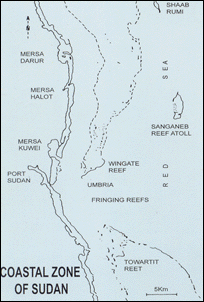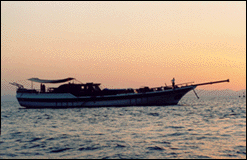 THE RED SEA AND DIVING THE RED SEA AND DIVING |

The coral reefs in the Sudan are still very untouched, and some experienced divers say that the worst dive sites in Sudan equal the best ones in Egypt! In former times the splendor of the reefs was accessible only to a few daring diving pioneers. For example the Frenchman Jacques Cousteau spent a lot of time close to Port Sudan in the Red Sea doing his various research on sharks and living underwater.
Now, however, the steady stream of diving tourists is coming to the Sudan and though the facilities on the main land in Port Sudan are still quite poor, there are plenty of boats and yachts taking you to the sea whether you want to experience snorkling, scuba diving or simply admire the beauty of the scenery.
Places to stay in Port Sudan are Hilton, opened in August 2001, but if you are going there to dive, it is best to contact some of the Italian divers with boats and yachts.
-Lorenzo: calling from abroad dial +249-122-77581 or +249-122-80117 or email lorenzoorzo@hotmail.com . He has a boat with good dive facilities and he makes sure your time in the Red Sea is as lively as anywhere else in the world!

-Maurizio: is a well-known seaman in the Red Sea. If you have been in the region, you might have met him in Yemen, Eritrea or Ethiopia on his wonderful yacht. At the moment he is based in the Sudan, but it is best to send him an email maumaha@hotmail.com or call him +249-123-41661 to check whereabouts on the Red Sea he is at the moment. Even if you are not a diver, it is the most forgettable experience to go on his boat, eat the fresh octopus and other fish, and watch the red sunset against the lighthouse and the mountains.
| There are plenty of dive sites in the Sudan close to the Port Sudan, one after another they are better. For example Umbria is an old 150 meters long Italian ship that sunk during the World War 2, where you can dive inside and see the old wine bottles.
Shaab Rumi is the site where Jacques Cousteau built his underwater laboratories and the cages where he observed the sharks. Diving there is like discovering Atlantis and the best thing is that this underwater residential area is not deeper than 25 meters.
Those interested in sharks; and if you are lucky you might see even hammer sharks, the best place is Sanganeb and its South point.
The best time for diving is from February until June, when the weather is not too hot. During the hottest month like July and August the visibility gets worse (but of course it is still well beyond 25 meters!).
So what is it that makes the Sudan excellent destination for those interested in sea life and the corals? The Sudanese coast has two prominent features: coastal lagoons, locally called mersas and reefs, called shaab in Arabic. The mersas may cut into the coastal plain well beyond the general coastline, as for example in Port Sudan. In mersas, in spite of heavy fresh water influx during the short rainy season, coral grow and build coral knobs (tens of centimeters to meters in size) and patch reefs (meters to ten meters in size). Reefs are distinguished according to their positions and shapes. There are fringing reefs, and with the exemption of the mersa entrances they line the entire coast. They are usually about 1000 m wide, but may be as wide as 3000 m. The most impressive coral growth and the richest fish life can be observed on the outside rim, but the protected inside also offers many interesting habitats and organism communities.
Secondly, there are barrier reefs. These are separated form the coast and fringing reef by a ship channel, generally about 100 m, but locally up to 400 m deep, and 2-4 km wide. The barriers range from narrow discontinuous reef walls, only several tens to a few hundred meters wide to platforms of up to 14 km wide which are dotted with patch reefs and depressions of several tens of meters depth. Towartit and Wingate Reefs are examples of this reef type.
The third type of reefs is the atoll, reef platforms located offshore and surrounded by waters of several hundred meters depth. The horizontal dimensions are hundred of meters to a few kilometers. Steep flanks rise to a very shallow reef rim which encloses lagoons several tens of meters deep. Sanganeb and Shaab Rumi are sites often visited. |

